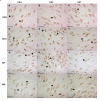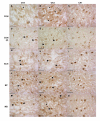Expression of POU-domain transcription factor, Oct-6, in schizophrenia, bipolar disorder and major depression
- PMID: 16246257
- PMCID: PMC1282578
- DOI: 10.1186/1471-244X-5-38
Expression of POU-domain transcription factor, Oct-6, in schizophrenia, bipolar disorder and major depression
Abstract
Background: The POU-domain transcription factor Oct-6 has been reported to be differentially expressed between schizophrenic and control post-mortem brains. In this study, we attempted to replicate this finding and to discover whether Oct-6 was also dysregulated in bipolar disorder and major depression.
Methods: Oct-6 mRNA and protein expression were determined by in-situ hybridization and immunohistochemistry respectively in sections of post-mortem brain.
Results: We did not observe any differences in Oct-6 expression between any of the groups under study. Oct-6 mRNA and protein was identically expressed in the hippocampal and cortical regions of most specimens in all groups, including controls.
Conclusion: Oct-6 is, therefore, unlikely to be a specific marker for any psychological disorder; rather its expression in controls suggests that it is normally expressed in most adult brains.
Figures




Similar articles
-
Hippocampal FGF-2 and FGFR1 mRNA expression in major depression, schizophrenia and bipolar disorder.Brain Res Bull. 2006 Jul 31;70(3):221-7. doi: 10.1016/j.brainresbull.2006.04.008. Epub 2006 May 12. Brain Res Bull. 2006. PMID: 16861106
-
Differences in the cellular distribution of D1 receptor mRNA in the hippocampus of bipolars and schizophrenics.Synapse. 2004 Dec 1;54(3):147-55. doi: 10.1002/syn.20076. Synapse. 2004. PMID: 15452863
-
Regional specificity of brain glucocorticoid receptor mRNA alterations in subjects with schizophrenia and mood disorders.Mol Psychiatry. 2002;7(9):985-94, 924. doi: 10.1038/sj.mp.4001139. Mol Psychiatry. 2002. PMID: 12399952
-
Oct-6 transcription factor.Int Rev Neurobiol. 2004;59:471-89. doi: 10.1016/S0074-7742(04)59018-9. Int Rev Neurobiol. 2004. PMID: 15006499 Review.
-
Genetic aspects of depression.Can Psychiatr Assoc J. 1966;11 Suppl:Suppl:29-33. Can Psychiatr Assoc J. 1966. PMID: 5328583 Review. No abstract available.
Cited by
-
Replication of association between schizophrenia and ZNF804A in the Irish Case-Control Study of Schizophrenia sample.Mol Psychiatry. 2010 Jan;15(1):29-37. doi: 10.1038/mp.2009.109. Epub 2009 Oct 20. Mol Psychiatry. 2010. PMID: 19844207 Free PMC article.
-
The transcription factor POU3F2 regulates a gene coexpression network in brain tissue from patients with psychiatric disorders.Sci Transl Med. 2018 Dec 19;10(472):eaat8178. doi: 10.1126/scitranslmed.aat8178. Epub 2018 Dec 13. Sci Transl Med. 2018. PMID: 30545964 Free PMC article.
-
Discriminative pattern discovery for the characterization of different network populations.Bioinformatics. 2023 Apr 3;39(4):btad168. doi: 10.1093/bioinformatics/btad168. Bioinformatics. 2023. PMID: 37021928 Free PMC article.
-
Single substitution in H3.3G34 alters DNMT3A recruitment to cause progressive neurodegeneration.Cell. 2023 Mar 16;186(6):1162-1178.e20. doi: 10.1016/j.cell.2023.02.023. Cell. 2023. PMID: 36931244 Free PMC article.
References
Publication types
MeSH terms
Substances
LinkOut - more resources
Full Text Sources
Medical

